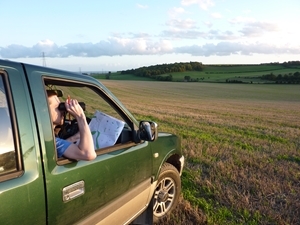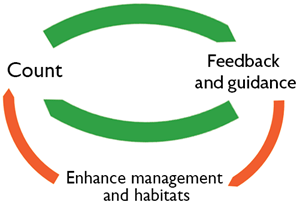What is the Partridge Count Scheme?
 The PCS is a free and voluntary scheme run by the GWCT since 1933 to collect information on the annual abundance and breeding success of grey partridges.
The PCS is a free and voluntary scheme run by the GWCT since 1933 to collect information on the annual abundance and breeding success of grey partridges.
In 1998 the GWCT was nominated Lead Partner for the Grey Partridge Biodiversity Action Plan (BAP) by the UK government. Under the banner ‘Every One Counts’, we relaunched the Scheme as fundamental to our initiative for saving the grey partridge.
Join the scheme online
Why grey partridges?
A “barometer of the countryside”, the grey partridge is a biodiversity indicator species of wider farmland. Grey partridges face many of the same challenges as many other farmland wildlife – food supply, nesting cover and the impacts of predation.
Where partridge can thrive, other species do too, especially other struggling farmland birds, but being a plump, medium-sized bird, grey partridges can be easier to observing than smaller farmland birds flittering around fields, especially for non-birders.
Importantly, grey partridges remain together as family groups – coveys – from hatching until the end of winter. This doesn’t just make them easier to count; it can reveal key information about breeding success, abundance and survival during the year without the need for continuous monitoring.
How does it work?
We believe that the future of the grey partridge rests in the hands of individuals on the ground through the management measures that they can implement. Counting will monitor the effect: successful measures will be reflected in subsequent counts, further encouraging landowners and managers to strengthen their efforts.

Who can take part?
We are looking for more farmers, landowners, land managers, keepers, etc, who are interested in helping conserve grey partridge on their land to join the PCS, count their partridges and submit their findings to us. There are no restrictions on how few partridges you must have to start with, nor must you have an interest in them as a quarry species.
For the grey partridge – Every one counts!
Join the scheme online
What do we require you to do?
Quite simply, undertake a partridge count twice a year:
Counts are done in early morning and/or late evening, and we provide detailed instructions on how to count.
What will you get from the Trust?
- Forms and instructions on how to count in a standardised and systematic way.
- Site-specific guidance based on your count results.
- A twice-yearly newsletter with national and regional summaries of count results, as well as news, advice and information about GWCT partridge research.
- In most regions, county-level Partridge Groups have been established that hold meetings that often include talks by GWCT partridge research and advisory staff, and often include farm visit/walk to see and discuss practical efforts. More of these will be organised as members increase in remaining counties.
Important
As strange as it may seem, areas where there are no partridges also need to be included in the scheme. It is important to confirm there are no birds in these areas and identify them as places for our efforts on expanding the current range.
Further reading
- Connor, H.E. & Draycott, R.A.H. (2010). Management strategies to conserve the grey partridge: the effect on other farmland birds. Aspects of Applied Biology, 100: 359-363.
- Ewald, J.A., Aebischer, N.J., Richardson, S.M., Grice, P.V., & Cooke, A.I. 2010. The effect of agri-environment schemes on grey partridges at the farm level in England. Agriculture, Ecosystems and Environment, 138: 55-63.
- Ewald, J.A. & Aebischer, N.J. (2010). Grey Partridge and agri-environment schemes: science, implementation and assessment. Aspects of Applied Biology, 100: 101-109.
- Aebischer, N.J. (2009). The GWCT Grey Partridge Recovery Programme: a Species Action Plan in action. In: Cederbaum, S.B., Faircloth, B.C., Terhune, T.M., Thompson, J.J. & Carroll, J.P. (eds) Gamebird 2006: Quail VI and Perdix XII: 291-301. Warnell School of Forestry and Natural Resources, Athens, USA.
- Ewald, J.A., Kingdon, N.G., & Santin-Janin, H. (2009). In: Cederbaum, S.B., Faircloth, B.C., Terhune, T.M., Thompson, J.J. & Carroll, J.P. (eds) Gamebird 2006: Quail VI and Perdix XII: 27-37. Warnell School of Forestry and Natural Resources, Athens, USA.
- Aebischer, N.J. & Ewald, J.A. 2004. Managing the UK Grey Partridge Perdix perdix recovery: population change, reproduction, habitat and shooting. Ibis, 146 Supplement 2: 181-191.
- Kingdon, N.G. & Darling, E.A.D. 2002. Using satellite imagery to aid the implementation of a recovery plan for a declining farmland bird. In: Chamberlain, D.E. & Wilson, A. (eds) Avian Landscape Ecology: Pure and Applied issues in the Large-Scale Ecology of Birds: 313-317. International Association for Landscape Ecology (UK).
- Potts, G.R. & Aebischer, N.J. 1995. Population dynamics of the Grey Partridge Perdix perdix 1793-1993: monitoring, modelling and management. Ibis, 137 Supplement 1: S29-S37.